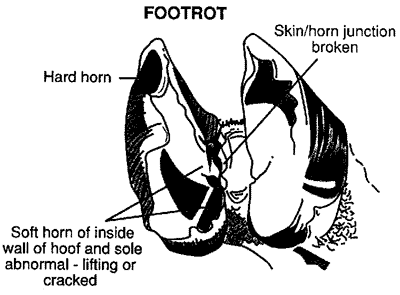Introduction/Causative Agents: Footrot is a serious disease that is difficult to cure. It is caused by two bacteria— Fusobacterium necrophorum and Bacteroides nodosus (Dichelobacter nodosus)— that act synergistically. F. necrophorum is common in most feces. It is very hardy and can almost always be found in sheep/goat environments. B. nodosus, on-the-other-hand, lives only in sheep/goat hooves. It grows very slowly and dies out in soil in 2 weeks. Many animals develop footrot after first being infected with F. necrophorum. The F. necrophorum infection mainly occurs in wet conditions were the tissue between the claws has been injured. An animal infected with F. necrophorum then becomes infected with a tissue destructive strain of B. nodosus when the foot contacts soil, manure, or bedding contaminated with B. nodosus. Certain breeds of sheep (Merino) seem to be more susceptible to the infection. Allowing excessive hoof growth to occur can also lead to a footrot problem.

Clinical Signs: Animals infected with footrot can be mildly to severely lame in one or more feet. The area between the toes is inflamed and moist. The problem spreads to the sole of the hoof causing it to separate from the underlying tissues. A characteristic foul odor and some discharge are often noticed.
Diagnosis: Cases of footrot are often diagnosed based on clinical signs and evidence of damage to the hoof. Footrot tends to infect more animals in the flock/herd at one time than does footscald. Cultures of samples taken from problem areas can be used to identify B. nodosus. Problems such as laminitis, bluetongue, and foot-and-mouth disease may also have symptoms similar to footrot.